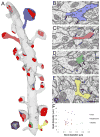Balancing structure and function at hippocampal dendritic spines
- PMID: 18284372
- PMCID: PMC2561948
- DOI: 10.1146/annurev.neuro.31.060407.125646
Balancing structure and function at hippocampal dendritic spines
Abstract
Dendritic spines are the primary recipients of excitatory input in the central nervous system. They provide biochemical compartments that locally control the signaling mechanisms at individual synapses. Hippocampal spines show structural plasticity as the basis for the physiological changes in synaptic efficacy that underlie learning and memory. Spine structure is regulated by molecular mechanisms that are fine-tuned and adjusted according to developmental age, level and direction of synaptic activity, specific brain region, and exact behavioral or experimental conditions. Reciprocal changes between the structure and function of spines impact both local and global integration of signals within dendrites. Advances in imaging and computing technologies may provide the resources needed to reconstruct entire neural circuits. Key to this endeavor is having sufficient resolution to determine the extrinsic factors (such as perisynaptic astroglia) and the intrinsic factors (such as core subcellular organelles) that are required to build and maintain synapses.
Figures

References
-
- Aakalu G, Smith WB, Nguyen N, Jiang C, Schuman EM. Dynamic visualization of local protein synthesis in hippocampal neurons. Neuron. 2001;30(2):489–502. - PubMed
-
- Abe K, Chisaka O, Van Roy F, Takeichi M. Stability of dendritic spines and synaptic contacts is controlled by alpha N-catenin. Nat Neurosci. 2004;7:357–63. - PubMed
-
- Ackermann M, Matus A. Activity-induced targeting of profilin and stabilization of dendritic spine morphology. Nat Neurosci. 2003;6(11):1194–200. - PubMed
-
- Adesnik H, Nicoll RA, England PM. Photoinactivation of native AMPA receptors reveals their real-time trafficking. Neuron. 2005;48:977–985. 977–85. - PubMed
-
- Allen NJ, Barres BA. Signaling between glia and neurons: focus on synaptic plasticity. Curr Opin Neurobiol. 2005;15(5):542–8. - PubMed
Publication types
MeSH terms
Grants and funding
LinkOut - more resources
Full Text Sources
Other Literature Sources

